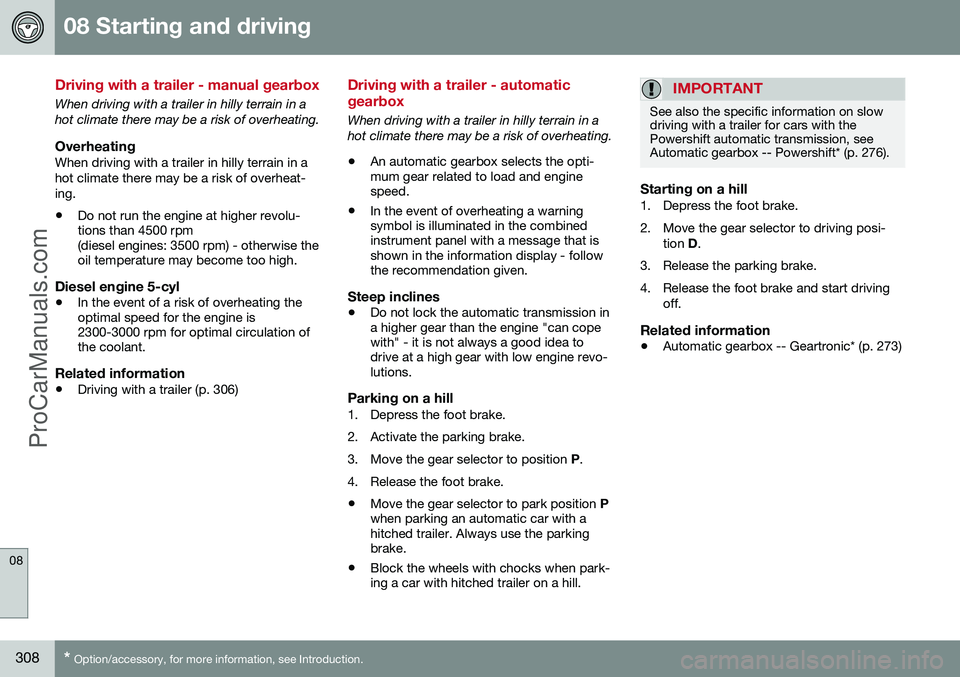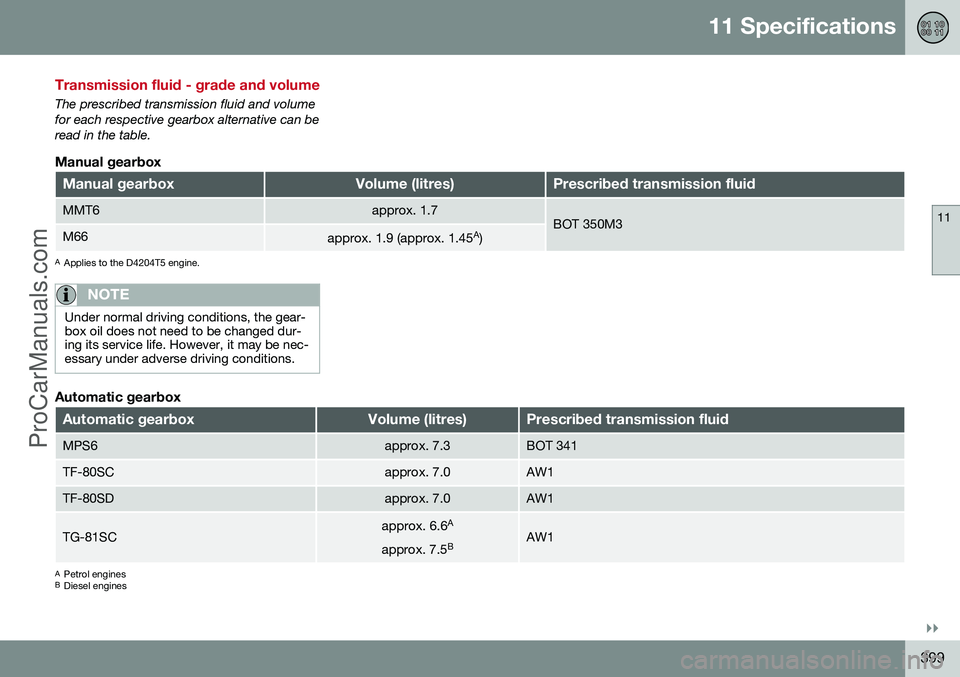2014 VOLVO V60 transmission
[x] Cancel search: transmissionPage 299 of 442

08 Starting and driving
08
297
Fording
Fording means that the car is driven through a water-covered roadway. Fording must be car-ried out with great caution. The car can be driven through water at a maximum depth of 25 cm at a maximumspeed of 10 km/h. Extra caution should beexercised when passing through flowingwater. During driving in water, maintain a low speed and do not stop the car. When the water hasbeen passed, depress the brake pedal lightlyand check that full brake function is achieved.Water and mud for example can make thebrake linings wet resulting in delayed brakefunction. •Clean the electric contacts of the electric engine block heater and trailer couplingafter driving in water and mud.
• Do not let the car stand with water overthe sills for any long period of time - thiscould cause electrical malfunctions.IMPORTANT
Engine damage can occur if water enters the air filter. In depths greater than 25 cm, water could enter the transmission. This reduces thelubricating ability of the oils and shortensthe service life of these systems. In the event of the engine stalling in water, do not try restart - tow the car from thewater to a workshop - an authorised Volvoworkshop is recommended. Risk of enginebreakdown.
Related information
•Recovery (p. 316)
• Towing (p. 313)
Overheating
Under special conditions, for example hard driving in hilly terrain and hot climate, there isa risk that the engine and drive system mayoverheat - in particular with a heavy load. For information about overheating when driv- ing with a trailer, see Driving with a trailer (p.306). • Remove any auxiliary lamps from in front of the grille when driving in hot climates.
• If the temperature in the engine's coolingsystem is too high then a warning symbolis illuminated in the combined instrumentpanel's information display and a text message
High engine temp Stop safelyis shown there - stop the car in a safe way and allow the engine to run at idlingspeed for several minutes in order to cooldown.
• If the text message
High engine temp
Stop engine or Coolant level low, Stop
engine is shown then the engine must be
switched off after stopping the car.
• In the event of overheating in the gearbox a built-in protection function is activatedwhich, amongst other things, illuminatesa warning symbol in the combined instru-ment panel, and its display shows the text message
Transmission hot Reduce
speed or Transmission hot Stop safely- follow the recommendation given and lower the speed and stop the car in a safeway and allow the engine to run at idling
ProCarManuals.co’
Page 310 of 442

08 Starting and driving
08
308* Option/accessory, for more information, see Introduction.
Driving with a trailer - manual gearbox
When driving with a trailer in hilly terrain in a hot climate there may be a risk of overheating.
OverheatingWhen driving with a trailer in hilly terrain in ahot climate there may be a risk of overheat-ing. • Do not run the engine at higher revolu- tions than 4500 rpm(diesel engines: 3500 rpm) - otherwise theoil temperature may become too high.
Diesel engine 5-cyl
•In the event of a risk of overheating theoptimal speed for the engine is2300-3000 rpm for optimal circulation ofthe coolant.
Related information
•Driving with a trailer (p. 306)
Driving with a trailer - automatic gearbox
When driving with a trailer in hilly terrain in a hot climate there may be a risk of overheating.
• An automatic gearbox selects the opti- mum gear related to load and enginespeed.
• In the event of overheating a warningsymbol is illuminated in the combinedinstrument panel with a message that isshown in the information display - followthe recommendation given.
Steep inclines
•Do not lock the automatic transmission ina higher gear than the engine "can copewith" - it is not always a good idea todrive at a high gear with low engine revo-lutions.
Parking on a hill1. Depress the foot brake.
2. Activate the parking brake.
3. Move the gear selector to position
P.
4. Release the foot brake.
• Move the gear selector to park position
P
when parking an automatic car with a hitched trailer. Always use the parkingbrake.
• Block the wheels with chocks when park-ing a car with hitched trailer on a hill.
IMPORTANT
See also the specific information on slow driving with a trailer for cars with thePowershift automatic transmission, seeAutomatic gearbox -- Powershift* (p. 276).
Starting on a hill1. Depress the foot brake.
2. Move the gear selector to driving posi-
tion D.
3. Release the parking brake.
4. Release the foot brake and start driving off.
Related information
• Automatic gearbox -- Geartronic* (p. 273)
ProCarManuals.co’
Page 316 of 442

||
08 Starting and driving
08
314
WARNING
•Check that the steering lock is unlocked before towing.
• The remote control key must be in keyposition
II - in position I all airbags are
deactivated.
• Never remove the remote control keyfrom the ignition switch when the caris being towed.
WARNING
The brake servo and power steering do not work when the engine is switched off - thebrake pedal needs to be depressedabout 5 times more heavily and the steer-ing is considerably heavier than normal.
Manual gearboxPrior to towing:
–Move gear lever into neutral and release the parking brake.
Automatic gearbox GeartronicPrior to towing:
–Move the gear selector to position
N and
release the parking brake.
Automatic gearbox PowershiftThe model with Powershift transmission should not be towed as it is dependent on theengine running in order to receive sufficient lubrication. If towing still has to take place,the route must be as short as possible andthen with very low speed. In the event of uncertainty as to whether or not the car is equipped with Powershift trans-mission, this can be verified by checking thedesignation on the gearbox label under thebonnet, see Type designations (p. 386). Thedesignation ”MPS6” means that it isPowershift transmission - otherwise it isGeartronic automatic transmission.
IMPORTANT
Avoid towing.
• However, the car can be towed for a short distance at low speed to move itfrom a dangerous position - not furtherthan 10 km and not faster than10 km/h. Note that the car mustalways be towed with the wheels roll-ing forward.
• In the event of moving a longer dis-tance than 10 km, the car must betransported with the drive wheelsraised from the road - professionalrecovery is recommended.
Prior to towing:
–Move the gear selector to position
N and
release the parking brake.
Jump startingDo not tow the car to bump start the engine. Use a donor battery if the battery is dis-charged and the engine does not start, seeJump starting with battery (p. 270).
IMPORTANT
The catalytic converter may be damaged during attempts to tow-start the engine.
Related information
• Towing eye (p. 315)
ProCarManuals.co’
Page 372 of 442

||
10 Maintenance and service
10
370* Option/accessory, for more information, see Introduction.
FunctionA
Relay coils5
Auxiliary lamps*20
Horn15
Relay coil in main relay for engine management system;Engine control module (4-cyl. 2.0 l B
, 5, 6-cyl.)10
Transmission control module15
Solenoid clutch A/C (not 4-cyl. 2.0 l C
, not 5-cyl. diesel); Sup-
porting coolant pump (4-cyl. 2.0 l diesel)15
Relay coil in relay for solenoid clutch A/C (not 5-cyl. diesel);Relay coil in relay for coolantpump (1.6 l petrol Start/Stop);Relay coils in central electricalunit in engine compartmentcold zone (Start/Stop)5
Start relay A30
FunctionA
Ignition coils (1.6 l petrol, engine B4204T7); Glow controlmodule (5-cyl. diesel)10
Engine control module (4-cyl. 2.0 l
B
); Ignition coils (5, 6-cyl.
petrol); Capacitor (6-cyl.)20
Engine control module (petrol except 4-cyl. 2.0 l C
)10
Engine control module (1.6 l diesel, 5-cyl. diesel)15
Engine control module (4-cyl. 2.0 l B
)20
FunctionA
Valves (1.6 l petrol); mass air flow sensor (1.6 l, 4-cyl. 2.0 l B
);
Thermostat (4-cyl. 2.0 l pet-rol B
); EVAP valve (4-cyl. 2.0 l
petrol B
); Cooling valve for cli-
mate control system (4-cyl. 2.0 l diesel); Cooling pump for EGR(4-cyl. 2.0 l diesel) Mass air flow sensor (engine D4162T); Control valve, fuelflow (engine D4162T)10
Mass air flow sensor (5-cyl. diesel, 6-cyl.); Control valves(5-cyl. diesel); Injectors (5, 6-cyl. petrol); Engine controlmodule (5-cyl. petrol, 6-cyl.)15
ProCarManuals.co’
Page 401 of 442

11 Specifications
11
}}
399
Transmission fluid - grade and volume
The prescribed transmission fluid and volume for each respective gearbox alternative can beread in the table.
Manual gearbox
Manual gearboxVolume (litres)Prescribed transmission fluid
MMT6approx. 1.7BOT 350M3M66approx. 1.9 (approx. 1.45A
)
A Applies to the D4204T5 engine.
NOTE
Under normal driving conditions, the gear- box oil does not need to be changed dur-ing its service life. However, it may be nec-essary under adverse driving conditions.
Automatic gearbox
Automatic gearboxVolume (litres)Prescribed transmission fluid
MPS6approx. 7.3BOT 341
TF-80SCapprox. 7.0AW1
TF-80SDapprox. 7.0AW1
TG-81SCapprox. 6.6 A
approx. 7.5 BAW1
A
Petrol engines
B Diesel engines
ProCarManuals.co’
Page 439 of 442

12 Alphabetical Index
12
437
Towbar
detachable, attachment...................... 310
detachable, removal........................... 311
Towbar, see Towing equipment.............. 309 Towbar - detachable attachment/removal.................... 310, 311
Towing..................................................... 313 towing eye.......................................... 315
Towing bracket........................................ 309 specifications...................................... 309
Towing capacity and towball load........... 391
Towing eye.............................................. 315
TPMS - Tyre Pressure Monitoring........... 330
Traction control........................................ 175
Trailer....................................................... 306 cable........................................... 306, 307
driving with a trailer............................ 306
snaking............................................... 312
Trailer stability assist............................... 176
Trailer Stability Assist.............................. 312
Transmission............................................ 271Transmission oil volume and grade............................... 399
Transponder.............................................. 17
Tread depth............................................. 321
Tread wear indicators.............................. 320 Trip computer.......... 104, 105, 109, 112, 113
Trip meter.................................................. 68
Trip meter, resetting................ 107, 110, 112Troubleshooting
Adaptive Cruise Control..................... 199
TSA - trailer stability assist ............. 176, 312
Tunnel console........................................ 139 12 V socket......................................... 141
cigarette lighter and ashtray............... 139
Tunnel detection........................................ 81 Type approval Bluetooth ®
.......................................... 414
radar system....................................... 413
remote control key system................. 412
tyre pressure monitoring..................... 412
Type designations................................... 386
Tyre dimension........................................ 322
Tyre load index........................................ 323
Tyre pressure label.................................. 328
Tyre pressure monitoring......................... 330 Adjust.................................................. 330
arming................................................. 331
deactivate........................................... 331
driveable punctured tyres (SST)......... 332
low tyre pressure................................ 331
recommendations............................... 332 Tyres
direction of rotation............................ 318
maintenance....................................... 318
pressure...................................... 328, 407
puncture repair................................... 333
specifications...................................... 407
tread depth......................................... 321
tread wear indicators.......................... 320
tyre pressure monitoring..................... 330
winter tyres......................................... 321
U
Unlockingfrom the inside.................................... 165
from the outside................................. 164
Unlocking with the key blade................... 162
V
Vanity mirror...................................... 88, 140
Ventilation................................................ 119
Vibration damper..................................... 309
Volvo Sensus............................................. 68
ProCarManuals.co’